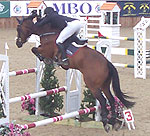Heart rate monitoring - an essential guide to equine fitness
 Equine
heart rate monitoring is one of the most reliable ways of measuring
a horse or pony's fitness.
Equine
heart rate monitoring is one of the most reliable ways of measuring
a horse or pony's fitness.
A resting horse normally has a pulse rate of 38 to 40 beats per minute.
During strenuous exercise, a horse or pony's heart rate can rise to over 180 beats per minute. However a heart rate over 80 in a resting horse, can be a symptom of a serious health problem.
Heart rate measurements must be taken at rest (usually best taken in the morning) and at work. The 'recovery rate' after work should also be calculated.
The pulse can be taken manually, by using a stethoscope - or by a more modern scientific approach such as employing a heart rate monitor. There are now heart rate monitors that have been specially manufactured for use with horses.
BENEFITS OF MONITORING A HORSE'S HEART RATE
- Establishing the horse's fitness levels at the beginning of training. You need to know what your horse's fitness level is at present and where any fitness programme should begin.
- Enabling the development of a long term programme for your chosen equestrian discipline and helping to define clearly, objectives within the potential of the horse.
- The early detection of illness, injury, excitement, temperament or anxiety problems - knowing what your horse's normal resting pulse rate is can help you to tell whether there is a health problem.
- To assist in obtaining the greatest progress in the shortest time.
- Monitoring the progress of a horse's fitness training regime.
WHY MONITOR YOUR HORSE'S HEARTRATE?
A new horse may have been developed for a different discipline from the one you wish him to follow.
The use of a heart rate monitor would determine at what level you must start your fitness programme.
HOW TO MONITOR A HORSE'S HEART RATE AND RECOVERY TIMES
The best way to do this is to note your horse?s resting heart rate each morning. Then:
- Measure a distance and mark it in metres or parts of a mile.
- Note his pre-exercise heart rate.
- Time how long it takes to walk the set distance you have marked and record his heart rate as he is walking.
- Once you have completed the distance, note how long takes for your horse to recover to his pre-exercise heart state.
- Do the same at trot and canter. Alternative method
- Walk for three minutes on both reins then trot for thre minutes.
- Allow the horse to recover.
- Then canter for three minutes.
- Note all the heart rates.
These tests will help you find out how fit your horse is an where to start your fitness programme. Use the tests weekly to assess his progress.
TAKING A HORSE'S PULSE
A horse's pulse can be found by placing your fingers against an artery. These can be found -
- Between the angle of the jaw and the front teeth.
- Just above and behind the eye
- In the hollow of the hoof
- Inside the foreleg, level with the knee joint
- Under the horse or pony's tail
HORSE CARE ADVICE AND EQUESTRIAN ARTICLES
Angleberry | Bog Spavin | Devil's Claw | Cold Back | Bran mash | Equine Redworm |Cushings disease | Herbs for Veterans | Hydrotherapy | Clivers | Equine Mud fever | Sarcoids | Feeding garlic | Horse bedding advice | Saddle Fitting | Iridology | Ringworm | Aubiose | Colic | Feeding vegetables | Equine Liver disease | Equine Body Work | Calming Herbs | Buying Trailer | Bot Eggs | Advice on Soaking Hay | Horse Nosebleeds | Sticky Stifle | Headshaking | Wiltshire Livery Yards | Herts Horsebox hire | Mare in Foal |
Equine heart rate monitoring is one of the most reliable ways of measuring
a horse or
pony's fitness. Advice on the benefits and how to take and monitor a horse's heartrate.